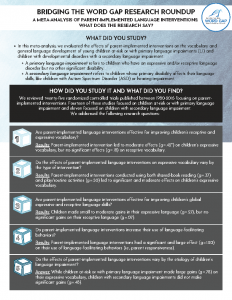Bridging the Word Gap Research Network
Research Briefs
Practice and Policy Briefs

How Home Visitors Can Help Bridge the Word Gap
The purpose of this research-based brief is to support Home Visitors in educating Parents and Caregivers on different strategies they can use to help bridge the word gap with their children.

How Healthcare Professionals Can Help Bridge the Word Gap
Healthcare professionals are often the most trusted and sometimes the only individuals outside of friends and family that have influence on parents and children. The purpose of this research-based brief is to support Healthcare Workers in educating Parents and Caregivers on different strategies they can use to help bridge the word gap with their children.

How Community Sectors Can Help Bridge the Word Gap
This research-based brief is a summary of the Community Action Plan put together by BWG Research Network and its purpose is to educate Community Leaders on the word gap and support Community Sectors in ways they can organize to help bridge the word gap.

How Policymakers Can Help Bridge the Word Gap
If you work with or want to support Dual Language Learners, the purpose of this research-based brief is to educate Policymakers on strategies to consider, to make positive outcomes for DLLs a goal when creating policy.
Briefs for Researchers

A Meta-Analysis of Parent-Implemented Language Interventions: What Does the Research Say?
We conducted a systematic review of language intervention studies conducted with young children from low-income backgrounds likely to experience the Word Gap. From a prevention perspective, we evaluated the strength of evidence supporting interventions conducted with this population as well as needed features for scalability and for replication by communities to produce population-level outcomes. We evaluated studies relative to the standards established by the Society for Prevention Science (see Gottfredson et al., 2015) that include evidence of ecological validity, rigor/trustworthiness, and readiness for scale-up.

Systematic Survey of Language Interventions Implemented by Early Childhood Educators, Early Interventionists, & Child Care Providers
Within the language intervention studies identified by the Bridging the Word Gap Research Network (Carta, Greenwood, & Walker, 2016), we selected 513 language intervention studies published between 1975 and 2015. Within that group of studies, we focused on the 190 studies targeting interventions delivered in child care and early education settings by early childhood educators, early interventionists, child care providers, and non-parental adults.

A Systematic Review of Language Intervention Research for Children from Low-Income Backgrounds: A Word Gap Prevention Perspective
We conducted a systematic review of language intervention studies conducted with young children from low-income backgrounds likely to experience the Word Gap. From a prevention perspective, we evaluated the strength of evidence supporting interventions conducted with this population as well as needed features for scalability and for replication by communities to produce population-level outcomes. We evaluated studies relative to the standards established by the Society for Prevention Science (see Gottfredson et al., 2015) that include evidence of ecological validity, rigor/trustworthiness, and readiness for scale-up.
